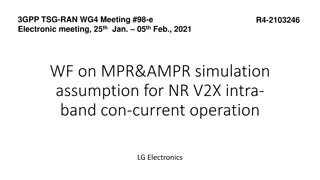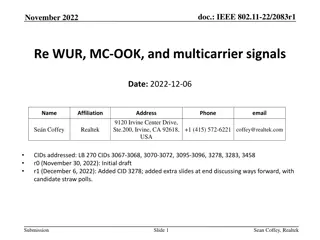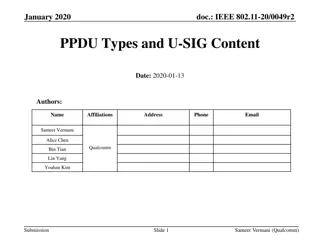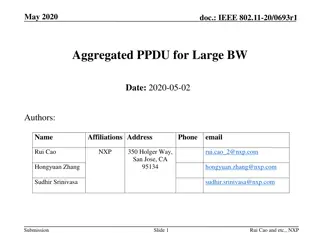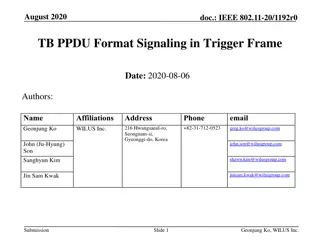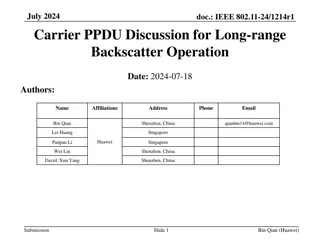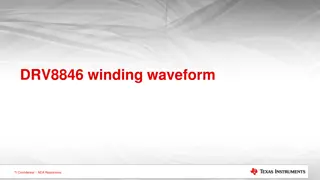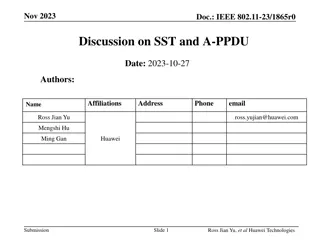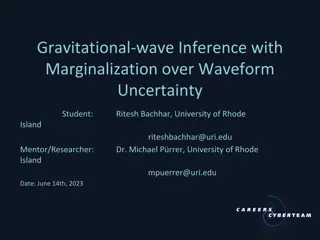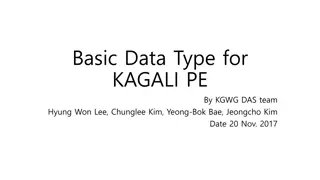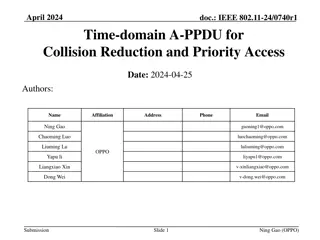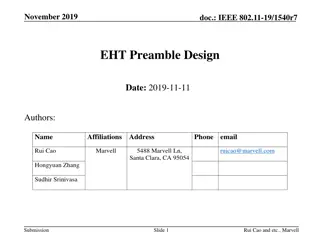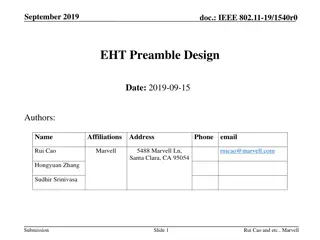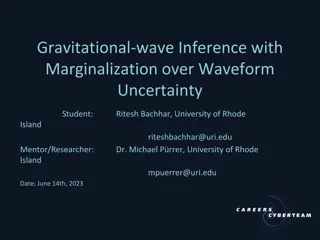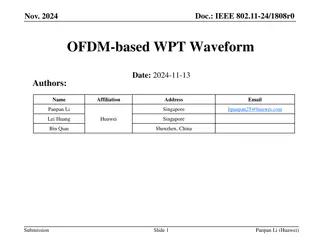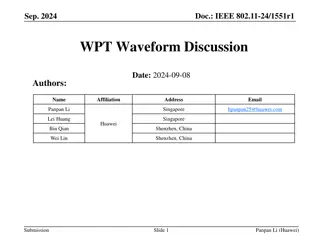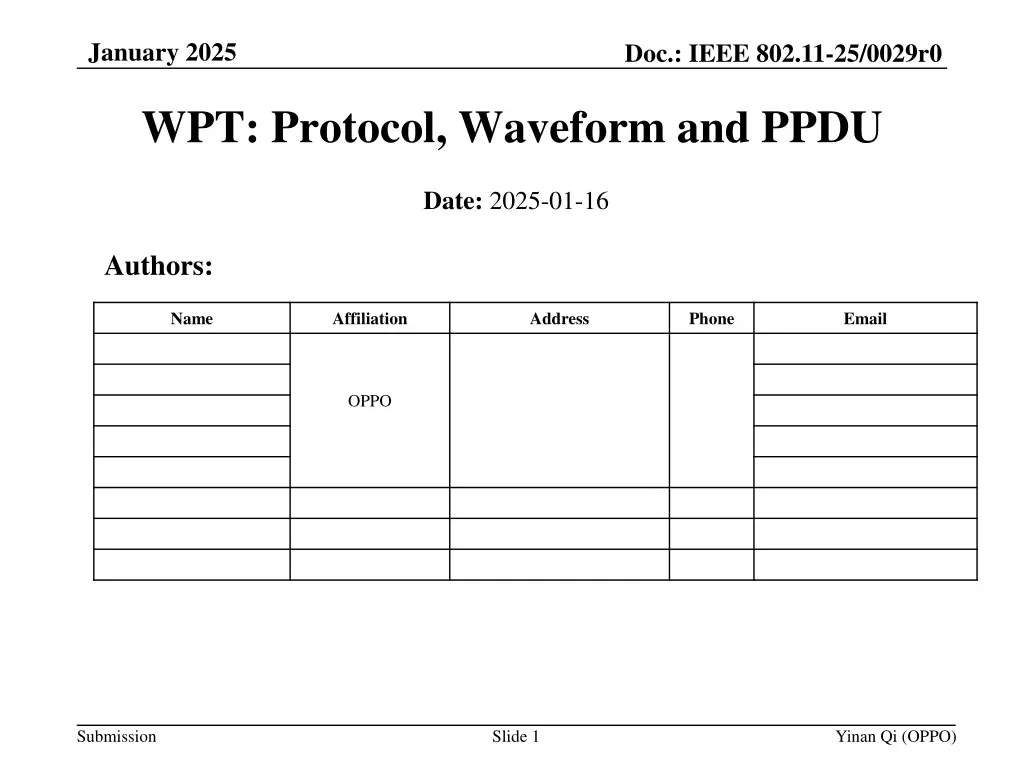
IEEE 802.11-25 WPT Protocol in January 2025
"Explore the WPT protocol in IEEE 802.11-25 for January 2025, covering aspects like control signaling, association, waveform, charging procedures, and feedback information between energizers, APs, and AMP devices."
Download Presentation

Please find below an Image/Link to download the presentation.
The content on the website is provided AS IS for your information and personal use only. It may not be sold, licensed, or shared on other websites without obtaining consent from the author. If you encounter any issues during the download, it is possible that the publisher has removed the file from their server.
You are allowed to download the files provided on this website for personal or commercial use, subject to the condition that they are used lawfully. All files are the property of their respective owners.
The content on the website is provided AS IS for your information and personal use only. It may not be sold, licensed, or shared on other websites without obtaining consent from the author.
E N D
Presentation Transcript
January 2025 Doc.: IEEE 802.11-25/0029r0 WPT: Protocol, Waveform and PPDU Date: 2025-01-16 Authors: Name Affiliation Address Phone Email OPPO Submission Slide 1 Yinan Qi (OPPO)
Doc.: IEEE 802.11-25/0029r0 January 2025 Abstract In this contribution, we discuss the following issues: o WPT protocol o Protocol between AP and energizer o Protocol between energizer and AMP device o Association between energizer and AMP device o WPT waveform o WPT PPDU Submission Slide 2 Yinan Qi (OPPO)
January 2025 Doc.: IEEE 802.11-25/0029r0 WPT Protocol [1] Part 1: define the control and signalling between energizer o Can be OOB at least for some specific topology, e.g., wired interface between AP and energizer o Key WPT info elements can be defined, indication, duty cycle related, e.g., on time, period, etc. Part 2: define the signalling between AP and AMP devices AP and AMP STA Part 2 e.g., on/off Part 1 Energizer AP Submission Slide 3 Yinan Qi (OPPO)
January 2025 Doc.: IEEE 802.11-25/0029r0 General WPT Procedure: Initialization WPT can be initialized by requesting for energizer and AMP reporting to initialize the WPT configuration. Report procedure can be either AP requested or autonomously done by energizer or AMP devices. Submission Slide 4 Yinan Qi (OPPO)
January 2025 Doc.: IEEE 802.11-25/0029r0 General WPT Procedure: Charging Procedure AMP requests WPT AP send WPT related parameters to energizer Energizer acks AP request and initiate WPT WPT and Tx/Rx procedures can repeat Submission Slide 5 Yinan Qi (OPPO)
January 2025 Doc.: IEEE 802.11-25/0029r0 WPT Protocol Part 1: Parameters Energizer sleep or active WPT frequency related information including central frequency, bandwidth, etc. WPT on/off WPT on/off duration o Duty cycle operation related information, e.g., period, on duration, etc., when WPT is on Indication the operation frequency: S1G or 2.4GHz WPT for active device or backscattering device DL PPDU format for 2.4GHz and/or WPT PPDU format if specified o Wakeup signal/PPDU format or parameters to define wakeup signal/PPDU, e.g., data rate, modulation scheme, etc. o Charging field related parameters: starting time, BW, waveform and Tx power. Submission Slide 6 Yinan Qi (OPPO)
January 2025 Doc.: IEEE 802.11-25/0029r0 WPT Protocol Part 2 Both long-term/non-periodic and short-term/periodic feedback can be supported o Long-term/non-periodic feedback info EH related information Energy storage related information o Short-term/periodic feedback info Power status/requirements o Long-term/non-periodic feedback can be done only one time during activation or based upon the request of AP o Short-term/periodic feedback can be more frequently, thus should be optionally switched on/off o Long-term/non-periodic feedback for all users but short-term/periodic feedback only for limited use cases, e.g., sensor o Joint feedback, e.g., power category should be supported to reduce signalling overhead as well as the power consumpsion. Submission Slide 7 Yinan Qi (OPPO)
January 2025 Doc.: IEEE 802.11-25/0029r0 Association of Energizer and AMP Devices AMP device not only associated with AP but also the energizer The association between energizer and AMP devices determines which energizer to activate to charge target AMP Such association can be established between energizer maintained by the AP This association is conventional association between AP and non-AP STA, e.g., such association can contain multiple to multiple mapping Association can reduce interference and energy consumption of energizers. For backscattering and wakeup signal, association is more critical. and AMP and different from Submission Slide 8 Yinan Qi (OPPO)
January 2025 Doc.: IEEE 802.11-25/0029r0 How to Establish the Association? Establishment o Energizer sending its own ID together with WPT signal to the AMP non-AP STAs. AMP non-AP STAs can report the ID back to the AP. o Sounding between energizer and AMP devices + CSI feedback o Enquiry by AP by activating energizers one by one and AP receiving AMP non-AP power related feedback o Position reporting from energizer and AMP devices This association may change and can be progressively updated based on AMP reporting Submission Slide 9 Yinan Qi (OPPO)
January 2025 Doc.: IEEE 802.11-25/0029r0 Without Association Without association o AP broadcasts to activate all energizer o AP groupcasts to activate energizers group by group o AP unicasts to activate energizers one by one Can be time consuming and cause heavy interference, leading to severe co-existence problem No association can be applicable to inventory use case For other user case, e.g., sensor, association can be beneficial Submission Slide 10 Yinan Qi (OPPO)
January 2025 Doc.: IEEE 802.11-25/0029r0 WPT Waveform Legacy waveforms are preferred o Pros: specification/implementation efforts o Candidates: OFDM, DSSS, single carrier, etc. o OFDM High PAPR High efficiency o Single Tone/Carrier Subset of OFDM with simple implementation complexity easy to implement, minimal Submission Slide 11 Yinan Qi (OPPO)
January 2025 Doc.: IEEE 802.11-25/0029r0 WPT PPDU: Co-existence Issue Co-existence not only for WiFi systems, e.g., 802.11ah but also for other S1G systems, e.g., Smart Utility Networks, Low Energy, Critical Infrastructure Monitoring, etc. WPT PPDU can overlap with each other but will interfere with non- WPT signals Submission Slide 12 Yinan Qi (OPPO)
January 2025 Doc.: IEEE 802.11-25/0029r0 WPT PPDU Basically, communication signal needs to be avoided by the energizer but WPT signal can co-exist. Design WPT signal that can be fully or partially understood by the energizer. WPT signal can contain both WPT preamble and charging segment and the WPT preamble can be understandable to energizers. Submission Slide 13 Yinan Qi (OPPO)
January 2025 Doc.: IEEE 802.11-25/0029r0 LBT for Energizers Energy Detection (ED) The energizer can do ED first. In the case of collision, the energizer needs to keep listening to the channel. Channel occupied (energy level > thresholdED) If a preamble is detected, the energizer Energizer does backoff knows the signal is WPT signal and it N Y N can transmit its own WPT signal. WPT preamble detected? Otherwise, it no preamble is detected, the energizer assumes the signal in the Y air is communication signal and does Transmit WPT signal backoff. Submission Slide 14 Yinan Qi (OPPO)
January 2025 Doc.: IEEE 802.11-25/0029r0 Reference [1] Further Consideration of WPT for AMP, IEEE 802.11-25/0029r0, Nov. 2024 Submission Slide 15 Yinan Qi (OPPO)
January 2025 Doc.: IEEE 802.11-25/0029r0 SP1 The following parameters can be considered for AP to control the energizer Energizer sleep or active o WPT frequency related information including central frequency, bandwidth, etc. o WPT on/off o WPT on/off duration o Duty cycle operation related information, e.g., period, on duration, etc., when WPT is on Indication the operation frequency: S1G or 2.4GHz o WPT for active device or backscattering device o DL PPDU format for 2.4GHz and/or WPT PPDU format if specified o Wakeup signal/PPDU format or parameters to define wakeup signal/PPDU, e.g., data rate, modulation scheme, etc. Charging field related parameters: starting time, BW, waveform and Tx power. Submission Slide 16 Yinan Qi (OPPO)
January 2025 Doc.: IEEE 802.11-25/0029r0 SP2 Do you agree to capture the following text to TGbp SFD? o AMP devices shall report power category to the AP during activation or upon the request of the AP? The details on how to define power category are TBD Submission Slide 17 Yinan Qi (OPPO)
January 2025 Doc.: IEEE 802.11-25/0029r0 SP3 Do you agree to capture the following text to TGbp SFD? o The association between energizer and AMP devices that determines which energizer to activate to charge target AMP devices should be supported Submission Slide 18 Yinan Qi (OPPO)
January 2025 Doc.: IEEE 802.11-25/0029r0 SP4 Do you agree to capture the following text to TGbp SFD? o 11bp supports OFDM and single carrier as WPT waveforms? Submission Slide 19 Yinan Qi (OPPO)
January 2025 Doc.: IEEE 802.11-25/0029r0 SP5 Do you agree to capture the following text to TGbp SFD? o WPT signals are allowed to overlap with each other. Submission Slide 20 Yinan Qi (OPPO)
January 2025 Doc.: IEEE 802.11-25/0029r0 SP6 Do you agree to capture the following text to TGbp SFD? o 11bp specifies, in S1G, WPT PPDU format with at least a preamble and a charging field? Submission Slide 21 Yinan Qi (OPPO)


